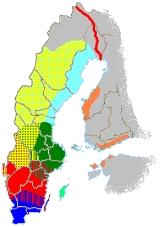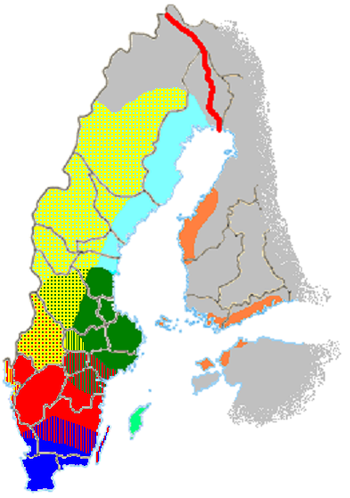
Swedish dialects
Encyclopedia
Swedish dialects can be categorized into Traditional Dialects (with no Standard Swedish
influence) and Modern Dialects (with various degrees of Standard Swedish influence).
 The linguistic definition of a Swedish traditional dialect
The linguistic definition of a Swedish traditional dialect
, in the literature merely called dialect, is a local variant that has not been heavily influenced by the standard language and that can trace a separate development all the way back to Old Norse
. Many of the genuine rural dialects have very distinct phonetic and grammatical features, such as plural forms of verbs or archaic case inflections. These dialects can be near-incomprehensible to a majority of Swedes, and most of their speakers are also fluent in Standard Swedish. The different dialects are often so localized that they are limited to individual parish
es and are referred to by Swedish linguists as sockenmål (lit. "parish speech"). They are generally separated into six major groups, with common characteristics of prosody, grammar and vocabulary (the color represents the core area and the samples are from Svenska Dagbladet's
dialect project):
The areas with mixed colors as stripes are transitional areas (övergångsområden, following the terminology of Gertrud Pettersson's Svenska under sjuhundra år).
The parts in yellow with coloured dots represent various distinct (särpräglade, following the terminology of Gertrud Pettersson's Svenska under sjuhundra år) dialect areas which are not easily defined belonging to any of the six major groups above. The areas west of the core for Norrländska mål, west of Sveamål and north of Göta are related to each of these, respectively, indicated by the colour of the dots. Samples from respectively area: Jämtland, Föllinge socken (related to Norrländska mål), Dalarna, Älvdalens socken (related to Sveamål) and Värmland, Nordmarks härad, Töcksmarks socken (related to Götamål). The dialects of this category have in common that they all show more or less strong Norwegian influences, especially the dialects in Härjedalen, Northwestern Jämtland and Northwestern Dalarna. Dialects are often showing similarities along traditional traveling routes such as the great rivers in Northern Sweden, which start in the mountains at the Norwegian border and then follow a South-Easterly path towards the Bothnian Sea
.
The grey area does not have any independently developed Swedish dialect.
Below we have a summary (from Svenska språket under sjuhundra år, Gertrud Pettersson) of some of the most important differences between the major groups.
Note that this table does not hold for the distinct (dotted) or transitional (striped) areas.
Standard Swedish
Standard Swedish denotes Swedish as a spoken and written standard language. While Swedish as a written language is uniform and standardized, the spoken standard may vary considerably from region to region...
influence) and Modern Dialects (with various degrees of Standard Swedish influence).
Traditional dialects

Dialect
The term dialect is used in two distinct ways, even by linguists. One usage refers to a variety of a language that is a characteristic of a particular group of the language's speakers. The term is applied most often to regional speech patterns, but a dialect may also be defined by other factors,...
, in the literature merely called dialect, is a local variant that has not been heavily influenced by the standard language and that can trace a separate development all the way back to Old Norse
Old Norse
Old Norse is a North Germanic language that was spoken by inhabitants of Scandinavia and inhabitants of their overseas settlements during the Viking Age, until about 1300....
. Many of the genuine rural dialects have very distinct phonetic and grammatical features, such as plural forms of verbs or archaic case inflections. These dialects can be near-incomprehensible to a majority of Swedes, and most of their speakers are also fluent in Standard Swedish. The different dialects are often so localized that they are limited to individual parish
Parish
A parish is a territorial unit historically under the pastoral care and clerical jurisdiction of one parish priest, who might be assisted in his pastoral duties by a curate or curates - also priests but not the parish priest - from a more or less central parish church with its associated organization...
es and are referred to by Swedish linguists as sockenmål (lit. "parish speech"). They are generally separated into six major groups, with common characteristics of prosody, grammar and vocabulary (the color represents the core area and the samples are from Svenska Dagbladet's
Svenska Dagbladet
Svenska Dagbladet is a daily newspaper in Sweden. The first issue appeared on 18 December 1884. Svenska Dagbladet is published in Stockholm and provides coverage of national and international news as well as local coverage of the Greater Stockholm region...
dialect project):
- Sydsvenska mål (dark blue); Sample (Skåne, Perstorps socken, N. Åsbo härad).
- Götamål (red); Sample (Västergötland, Korsberga socken, Vartofta härad, Skaraborgs län).
- Sveamål (dark green); Sample (Uppland, Håtuna socken, Håbo härad).
- Norrländska mål (light blue); Sample (Västerbotten, Skellefte socken, Löparnäs).
- Östsvenska mål (orange); Sample (Finland, Österbotten, Sideby socken).
- Gotländska mål (light green); Sample (Gotland, Lau Socken, Gotlands södra härad).
The areas with mixed colors as stripes are transitional areas (övergångsområden, following the terminology of Gertrud Pettersson's Svenska under sjuhundra år).
The parts in yellow with coloured dots represent various distinct (särpräglade, following the terminology of Gertrud Pettersson's Svenska under sjuhundra år) dialect areas which are not easily defined belonging to any of the six major groups above. The areas west of the core for Norrländska mål, west of Sveamål and north of Göta are related to each of these, respectively, indicated by the colour of the dots. Samples from respectively area: Jämtland, Föllinge socken (related to Norrländska mål), Dalarna, Älvdalens socken (related to Sveamål) and Värmland, Nordmarks härad, Töcksmarks socken (related to Götamål). The dialects of this category have in common that they all show more or less strong Norwegian influences, especially the dialects in Härjedalen, Northwestern Jämtland and Northwestern Dalarna. Dialects are often showing similarities along traditional traveling routes such as the great rivers in Northern Sweden, which start in the mountains at the Norwegian border and then follow a South-Easterly path towards the Bothnian Sea
Bothnian Sea
The Bothnian Sea links the Bothnian Bay with the Baltic proper. Kvarken is situated between the two. Together, the Bothnian Sea and Bay make up a larger geographical entity, the Gulf of Bothnia...
.
The grey area does not have any independently developed Swedish dialect.
Below we have a summary (from Svenska språket under sjuhundra år, Gertrud Pettersson) of some of the most important differences between the major groups.
| Feature | Sydsvenska mål | Götamål | Sveamål | Norrländska mål | Östsvenska mål | Gotländska mål |
|---|---|---|---|---|---|---|
| Diphthongs | Secondary in most of the area | No | No | Primary and secondary in north | Primary | Primary and secondary |
| Long a > å | Yes (secondary diphthong) | Yes | Yes | Yes in south | Yes | No |
| p, t, k > b, d, g | In most of the area | No | No | No | No | No |
| Intervocalic g > j or w | In most of the area | No | No | No | No | No |
| Ending vowel -a | Remains | Weakened in parts of the area | Remains | Vowel balance | Vowel balance | Weakened in most of the area |
| Dropping of -r in plur. | Yes | Yes | No | Yes | No | No |
| Allophone of r | Back | Front | Front | Front | Front | Front |
| Postpos. poss. pron. | No | Only family words | Only family words | Yes | Yes | Only family words |
| Softening initial g, k, sk | Yes | Yes | Yes | Yes | Yes | No |
| Dropping of -n | No | Yes | Only in a small part of the area | Yes | No | Yes |
| Dropping of -t | No | Yes | Yes | Yes | Yes | Yes |
| "Thick" l, also of rd | No | Yes | Yes | Yes in south | Only in the west | No |
| Supradentals | No | Yes | Yes | Yes | Only in the west | No |
| Dropping of -de in pret. | In parts of the area | In parts of the area | Yes | Yes | Yes | Only -e is dropped |
| Prolong. vowel in short stemmed words, also in front of p, t, k, s | Yes | Yes | No | Some of the system of short stemmed words preserved | Some of the system of short stemmed words preserved | No |
| Stem vowel i, y > e, ö, also in long stemmed words and in front of i, u | Yes | Yes | No | No | No | No |
| Vowel balance | No | No | No | Yes | Yes | No |
Note that this table does not hold for the distinct (dotted) or transitional (striped) areas.
See also
- Norwegian dialectsNorwegian dialectsThe Norwegian dialects are commonly divided into 4 main groups, North Norwegian , Trøndelag Norwegian , West Norwegian , and East Norwegian...
- Danish dialects
- North Germanic languagesNorth Germanic languagesThe North Germanic languages or Scandinavian languages, the languages of Scandinavians, make up one of the three branches of the Germanic languages, a sub-family of the Indo-European languages, along with the West Germanic languages and the extinct East Germanic languages...
- Scanian dialects
External links
- More samples, from many dialects not listed in this article. (Swedish site)

